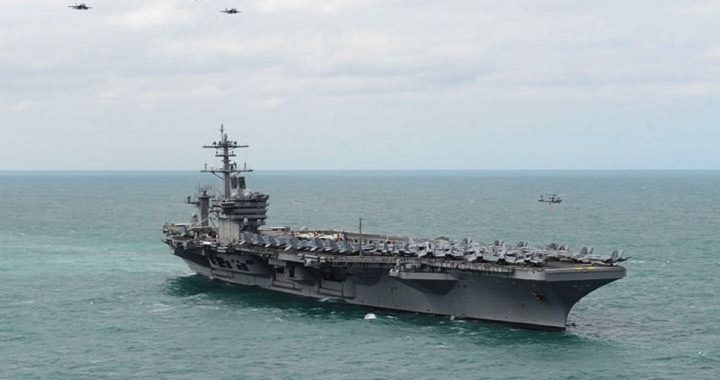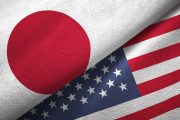
As a Chinese carrier group is set to engage in naval drills near Hainan — a Chinese province consisting of several islands in the South China Sea — the USS Theodore Roosevelt (shown), leading a carrier strike group, entered that sea on April 10 conducting what the U.S. military called a routine training mission. The U.S. carrier group is headed for a port call in the Philippines.
Hainan Province maritime officials have reportedly issued a temporary ban on travel in waters near the islands because of the Chinese naval maneuvers that are scheduled to take place from April 12 through 18.
UPI reported that the Roosevelt is sailing within the “nine-dash line” that extends more than 1,200 miles from the Chinese mainland into the South China Sea. Beijing claims the waters as its own, while the United States and other nations maintain that the area is in international waters.
Reuters reported that the United States is not alone in carrying out naval patrols in the strategic waterway, where Chinese, Japanese, and some Southeast Asian navies operate, possibly increasing tensions and risking accidents at sea.
“We have seen Chinese ships around us,” Rear Admiral Steve Koehler, the strike group commander, told a group of reporters on board the Theodore Roosevelt. “They are one of the navies that operate in the South China Sea but I would tell you that we have seen nothing but professional work out of the ships we have encountered.”
The Reuters report noted that the United States has criticized China’s apparent militarization of manmade islands in the South China Sea and carried out regular air and naval patrols to assert its right to freedom of navigation in portions of the sea that China claims as its own.
“This transit in the South China Sea is nothing new in our planning cycle or in a reaction to that. It is probably by happenstance that all that is happening at the same time,” said Koehler.
“[The Chinese] certainly have the right to exercise off their coast like we do, nor are they necessarily in charge of our transit cycle, but our deployment’s been planned,” Koehler continued.
“I haven’t seen any dangerous interaction,” Koehler said, adding that problems could be avoided “if all the navies are operating in accordance with the international norm and law.”
An AP report said that the U.S. Navy flew a small group of Philippine generals, officials, and journalists to the Theodore Roosevelt, and Reuters reported that the crew gave a tour of the carrier to these guests.
The visitors also were treated to a display of aircraft taking off and landing on the carrier. “It is a showcase of the capability of the U.S. armed forces, not only by sea but also by air,” Philippine army chief Rolando Bautista said of the demonstration. “Since Americans are our friends in one way or another, they can help us deter any threat.”
AP reported that at least twice this year, the U.S. Navy has deployed destroyers in freedom-of-navigation sail-bys near Chinese-occupied Scarborough Shoal, which Beijing wrestled from the Philippines in 2012, and Manila-claimed Mischief Reef, which Chinese forces occupied in 1995.
Another U.S. carrier, the USS Carl Vinson, patrolled the contested waters last month, taking part in anti-submarine drills in the South China Sea with Japanese forces and also visiting Vietnam. The visit by the Carl Vinson, which has a 5,000-member crew, was the largest such U.S. military presence there since the Vietnam War ended in 1975.
The area of the South China Sea near Hainan, where the Chinese navy is now undergoing maneuvers, represents only a very small portion of the area of the sea within the “nine-dash line,” which has never been formally defined. This vague line of demarcation was originally established by the Republic of China before the communist takeover of mainland China. It has been subsequently referred to at times by the communist government of the People’s Republic of China and the non-communist government of the Republic of China, on Taiwan. The “nine-dash line” is used by both rival Chinese governments to substantiate the claims over a major part of the South China Sea. The contested area includes the Paracel Islands, the Spratly Islands, and other areas including the Pratas Islands, the Macclesfield Bank, and the Scarborough Shoal.
In January 2013, the Philippines formally initiated arbitration proceedings against China’s territorial claim on the “nine-dash line,” which it said is unlawful under the United Nations Convention on the Law of the Sea (UNCLOS).
One island group that has been the subject of highly contested claims is the Spratly Islands, which China calls the Nansha Islands. The Spratlys are made up of approximately 750 islands and islets with a combined area of only 1.5 square miles, but the countries that presently have claims to the islands are Brunei, mainland (Communist) China, Malaysia, the Philippines, the Republic of China (Taiwan), and Vietnam.
In an article in May 2015, we cited an editorial in the Global Times, a newspaper owned by the Chinese Communist Party’s People’s Daily, which said that “U.S.-China war is inevitable in the South China Sea … if the United States’ bottom line is that China has to halt its activities” in the Spratly Islands.
We wrote that China is in the process of constructing seven artificial islands amidst the Spratlys/Nanshas, and the United States fears that the communist nation might attempt to impose air and sea restrictions in the chain once it completes that construction.
Since construction began, the U.S. Navy has flown P8-A Poseidon surveillance aircraft over the sites to gather intelligence about the Chinese activities. After a P-8A flew over the Chinese construction zone on May 20, 2015 the Chinese Navy contacted the plane by radio and asked it to leave the area.
An article in Britain’s Telegraph reported on May 22, 2015 that China was “strongly dissatisfied” with the U.S. flights over its island construction sites.
In response, then-Assistant Secretary of State Daniel Russel told reporters that the P-8A reconnaissance flight was “entirely appropriate” and that U.S. naval forces and military aircraft would “continue to fully exercise” the right to operate in international waters and airspace.
The islands remain a point of controversy to this day. An April 10 NPR report quoted this item from the Wall Street Journal:
A U.S. Defense Department official, describing the finding, said: “China has deployed military jamming equipment to its Spratly Island outposts.”
The U.S. assessment is supported by a photo taken last month by the commercial satellite company DigitalGlobe and provided to The Wall Street Journal. It shows a suspected jammer system with its antenna extended on Mischief Reef, one of seven Spratly outcrops where China has built fortified artificial islands since 2014, moving sand onto rocks and reefs and paving them over with concrete.”
NPR continued its report by observing that a spokesperson for China’s Ministry of Defense declined on April 10 to directly respond to the report, but said the Spratly Islands — which are also claimed by Taiwan, Vietnam, Malaysia, and the Philippines — are “Chinese territory.”
The NPR report concluded:
China’s muscle flexing has brought the U.S. and Chinese navies into increasingly close and frequently uncomfortable contact, including Cold-War-style cat-and-mouse games in the region that have increased international tensions.
Related article:
U.S.-China War “Inevitable” If U.S. Continues Flights Over Claimed Islands



